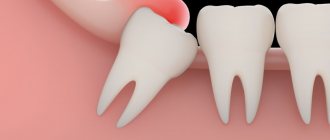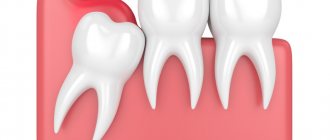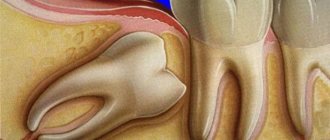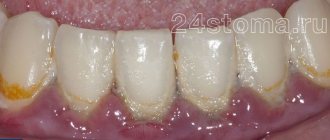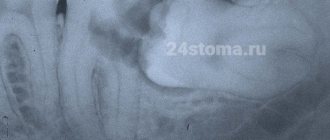For many people, as practice shows, panic is caused by the mere fact that it is necessary to remove a wisdom tooth. This is due to the fact that patients imagine the procedure itself as painful. But the days when a dentist spent more than 2-3 hours chiseling out roots piece by piece with a hammer and chisel are long gone.
Modern clinics use new technologies and techniques, thanks to which the removal of a wisdom tooth in the upper jaw is quick, in a comfortable environment and absolutely painless.
Features and difficulties during removal
Extraction of the upper wisdom tooth is complicated by its specific anatomical features.
“Eights” erupt late, when the dentition is already formed. Therefore, very often they are incorrectly located, grow together with the roots of neighboring teeth, grow towards the cheek or even horizontally. Each of these factors complicates the extraction process placed on top of the 8th tooth. But if we compare wisdom tooth removal from above and below, then in the first case the surgical procedure is much simpler. In the upper dentition, the bone is less dense and massive, there are much fewer blood vessels in the soft tissues and the risks of damage to the trigeminal nerve are lower. Therefore, the operation to remove the G8 is easier and safer.
Useful tips
Before removing an incorrectly positioned wisdom tooth, we offer a number of tips that will help you prepare and go through the operation more comfortably:
- Try to make an appointment for tooth extraction in the morning. During the night, the hormone cortisol accumulates in the body, which helps to survive stressful situations. In addition, one should take into account the fact that the inevitable bleeding from the wound at the site of the former tooth will stop by the evening, and the person will be able to sleep peacefully.
- Eat well before surgery. As a result, saliva will be released in smaller volumes, and then you will need to leave your jaws alone and not eat for some time.
- If possible, immediately use a cold object and periodically apply it to your cheek on the way home to prevent swelling from forming. A pack of dry ice from a motorist's first aid kit will do.
- At home, rinse your mouth with clean water or medications recommended by your doctor.
- Take medications in the correct dosage, do not get carried away with self-medication and self-prescription of drugs.
Recommendations for a better rehabilitation period after removal of an impacted wisdom tooth:
- You will need to allow a blood clot to form at the site of the extracted tooth. His presence is mandatory. The clot protects the socket from the penetration of bacteria and prevents complete deformation of the gums. Dry socket is dangerous and provokes inflammation.
- Do not touch the blood clot with your tongue, toothbrush bristles, or cutlery. It is not even recommended to use mouth rinse for 2-3 days after surgery. It is better to take the medicine into your mouth, hold it for a while and spit, avoiding the chance of dislodging the clot.
- To stop bleeding, it is permissible to use sterile cotton wool or gauze swabs. It is allowed to moisten with Chlorhexidine, Miramistin. It is prohibited to use hydrogen peroxide!
- For several days you will have to eat soft food and maintain an acceptable temperature of food and drinks.
- You are supposed to temporarily give up physical activity and training. Baths and saunas, swimming pools, solariums are prohibited.
- You cannot heat the surgical area, as this will cause a dangerous inflammatory process. You can apply ice, but under no circumstances keep it on your cheek all the time. Optimal rhythm: 5 minutes cooling, 5 minutes break. If you don’t have ice at home, bags of frozen vegetables and meat from the freezer will do.
- Maintaining oral hygiene is not prohibited. The main thing is to leave the operated area alone in the first days and not try to thoroughly clean the teeth located near the wound. Disinfection can be carried out with solutions of Chlorhexidine, Furacilin, holding it in the mouth and spitting it out, without rinsing.
Medicine knows of cases when wisdom teeth are prescribed to be preserved. But if it grows, pushing neighbors, lies horizontally or rests on the roots of nearby teeth, there is no need to think twice. Such an eight is considered problematic and is deleted without regret.
Perforation of the bottom of the maxillary sinus, diagnosis and treatment
If a wisdom tooth grows horizontally and puts pressure on the adjacent tooth
Features of tooth extraction in the upper jaw
The structure of the upper and lower jaws is significantly different. They also vary in density and location. Therefore, the method of tooth extraction will differ:
- on the upper jaw the operation is faster;
- the recovery period is shorter;
- pain relief is simpler and more effective.
Complications during tooth extraction in the upper jaw occur less frequently than in the lower jaw.
Anesthesia
The secret of high-quality pain relief is the correct delivery of the drug to the nerve. The choice of anesthesia method takes into account the patient’s age, his general condition, and the complexity of the tooth being removed.
Anesthesia of the upper jaw
The upper jaw is less dense than the lower jaw. It is covered with a cortical plate with many holes. Nerves and blood vessels pass through them. Pain relief is easier and faster than in the lower jaw
Sinus damage
Above the upper jaw is the nasal sinus, also known as the maxillary sinus. Its bottom may be close to the root of the tooth being removed. Then, during removal, sinus perforation may occur. This complication is typical for surgery on molars. This pattern is explained by the fact that the jaw in the area of the incisors is longer, and the nasal cavity is further away relative to them.
The main sign of sinus perforation is the escape of air, food and fluid through the nose. There is foam in the hole. Hospitalization in a hospital may be indicated for treatment.
Entry of part of the root into the sinus
Due to perforation of the sinus, part of the root can get inside it. This is caused by thinning of the bone plate or errors during the removal operation.
The symptoms when part of the root gets into the sinus are the same as when perforation occurs: air and contents of the oral cavity escape through the nose. But at the same time there is pain and increased body temperature. Treatment requires hospitalization.
Symptoms
The growth of a wisdom tooth does not go unnoticed, especially if it grows horizontally. So, the main signs of eruption of the third molar , upon seeing which it is better to consult a doctor:
- pain in the gums on a constant basis;
- inflammatory disease process;
- discomfort when moving the jaw;
- bleeding;
- change in bite;
- temperature increase;
- a hood over an erupted tooth, causing discomfort.
IMPORTANT The sooner a person visits the dentist, the higher the chances of avoiding complications.
Preparing for surgery
Before removing a wisdom tooth in the upper jaw, the doctor prepares the patient for the upcoming operation. The preparatory process consists of:
- X-ray examination of the problematic tooth;
- clinical examination of the patient for the presence of pathologies and other concomitant diseases that may affect the course of the operation;
- removal of subgingival and supragingival deposits from the tooth being removed and adjacent teeth to prevent the penetration of infected plaque into the alveolus.
The surgeon also assesses the patient’s psycho-emotional state and, if necessary, recommends taking a sedative.
Why is dystopia dangerous?
Failure to see a dentist in a timely manner can lead to complications such as:
- A wisdom tooth that fits tightly to the wall of a healthy neighboring tooth will destroy its enamel and a carious cavity will form.
- A horizontally growing figure eight will harm the entire dentition and cause crowding and malocclusion.
- The sharp edge of the crown will damage the mucous membrane and begin to cause persistent pain. The area will become inflamed and a wound will open, which can become infected.
- The soft tissues of the face, cheeks and gums gradually fester. There is a high probability of trigeminal neuralgia, periodontitis, cysts and fistulas, and if left untreated, phlegmon can spread.
- Chewing and opening your mouth will become difficult due to pain.
- In some cases, body temperature rises.
- A deep-lying figure eight touches nearby vessels. Due to their damage, constant bleeding occurs.
- Malignant and benign tumors will appear due to the pressure of the molar on the cheek and the degeneration of the affected areas.
Easy removal
When nothing prevents you from removing the tooth from the socket and cutting the gums with a scalpel is not required, then such removal is considered simple. The procedure is carried out in the following order:
- the doctor orders an x-ray or recommends a CT scan;
- the problem area is numbed with local anesthetics;
- Using forceps, the surgeon first rocks the tooth and then pulls it out of the socket.
After the tooth is removed, the hole is treated with an antiseptic solution, after which a sterile swab is applied to it. If necessary, the wound is sutured. The entire procedure lasts about 10 minutes.
Difficult removal
Such an operation is considered difficult when the upper molar has to be extracted in parts with an incision in the gum and sawing of the crown. The procedure occurs in stages:
- X-ray or CT scan;
- gum pain relief. In case of a complex clinical picture, it is possible to perform the operation under general anesthesia;
- dissection of the gum is performed to open access to the crown;
- the surgeon pulls out the molar. It is often necessary to first remove the crown with a drill to ensure free access to the roots;
- the hole is carefully checked for the presence or absence of bone fragments.
In cases of bone resection, the hole is filled with special bone chips, which subsequently form new bone tissue.
Since the operation is complex, the rehabilitation period is longer and can last for several weeks.
Pain after removal of upper wisdom tooth
It should be understood that removing an upper wisdom tooth is much more difficult than removing any other unit in the dentition. The patient does not feel any pain during the operation. But when the anesthesia wears off, pain is inevitable.
To relieve pain, you should take painkillers recommended by your doctor. Cold compresses applied to the cheek relieve pain.
If within 3-5 days the pain does not disappear, but becomes more intense, then you should seek help from a dentist to find out the cause of this condition.
Can third molars be treated?
Wisdom teeth, like any other teeth, can be treated. But only if they erupt correctly, do not threaten the health and position of the rest of the dentition, and there is confidence that the treatment will be successful. If the specified conditions are met, it makes sense to preserve the “eight” for the following indications:
- If the sixth and seventh teeth are sick or severely damaged and must be removed, in this case the wisdom tooth is left as “the best of the worst” in order to provide the patient with at least some conditions for chewing, and the doctor - the basis for future prosthetics.
- If the six and seven have already been removed and it is necessary to preserve the abutment tooth for installation of prosthetic structures.
- In the presence of an antagonist tooth, completely healthy and subject to preservation.
In case of curved roots that complicate endodontic intervention, severe tissue destruction, dystopia or retention, no competent dentist will undertake to treat the “eights” - he will definitely recommend removal.
What to do if the bleeding does not stop
Immediately after removing a molar, the surgeon places a tampon on the socket to stop capillary bleeding. The patient needs to clench his jaw and not remove the tampon for 20 minutes. During this time, the blood coagulates and a clot forms in the hole, protecting the fresh wound from the penetration of bacteria into it.
If the patient has high blood pressure or poor blood clotting, the tampon should be kept in place for 40-60 minutes.
When a person strictly adheres to medical recommendations, but the bleeding does not stop, he should contact a dentist for help.
Consequences and possible complications
It is necessary to separate the consequences of the operation and complications after it. All patients experience consequences to one degree or another - this is a normal reaction of the body to intervention, but it is better to avoid complications.
Consequences include:
- painful sensations;
- bleeding gums within 3-5 hours after surgery;
- swelling of the gums, cheeks;
- bruises on the face in the area of intervention;
- rise in temperature.
Complications may be as follows:
- prolonged bleeding
- due to the fact that the tissues around the lower “eights” are saturated with blood vessels. In this case, the doctor may apply additional hemostatic measures; - alveolitis
- inflammation of the wound surface associated with infection in the hole. It is characterized by the following symptoms: fever, bad breath, swelling, pain. Requires additional wound treatment and antibiotics; - paresthesia
- loss of facial sensation. Usually the lips, cheeks, and tongue suffer - they do not feel touch, do not distinguish between hot and cold. Loss of sensitivity is associated with damage to the facial nerve and may go away on its own within 1-2 weeks, but in some cases requires additional therapy; - dislocation of the mandibular joint
is a rare but possible complication associated with excessive efforts made by the surgeon to extract the tooth. The dislocation can be corrected immediately.
Attention!!!
Removing a problematic lower molar is a full-fledged operation, so special attention should be paid to the recovery period. It is necessary to strictly follow the doctor’s recommendations and carefully care for the oral cavity, then the likelihood of developing the complications described in the previous section will be minimal. Standard assignments include:
- taking painkillers and antihistamines
- antibacterial rinses
- cold compresses on the cheek in the area of intervention (reduce hematomas and reduce the risk of re-bleeding)
- prohibition on eating during the first hours after surgery
- ban on smoking, drinking alcohol, physical activity
- ban on visiting the sauna and swimming pool, taking hot baths
If the doctor did not make mistakes during the operation, and the patient does not violate the recovery regime, then very soon there will be no trace of unpleasant sensations.
Safe and high-quality removal of wisdom teeth in Balashikha
The Berezka dental clinic offers qualified assistance to anyone who, for certain reasons, requires the removal of a wisdom tooth from above or below. The operations are performed by experienced surgeons using safe anesthesia and modern instruments.
Before the procedure, the dentist collects the patient’s medical history, conducts all the necessary examinations, and only if the clinical picture is present is it possible to extract the wisdom tooth.
The operation is performed in a comfortable environment for the patient. Innovative equipment and professional dentists ensure successful and safe removal of the most complex teeth.
Reasons for the formation of pus in the gums
There are several reasons for the formation of pus:
- The inflammatory process causes a disease such as periodontal disease (gingivitis).
- Periodontal disease.
- Mechanical damage to the gums.
- Chemical or thermal burn.
- Unprofessional removal of tartar, which affected the gums.
- Extensive caries causes pulpitis.
- Failure to comply with hygiene standards when performing dental procedures.
- Unsanitary oral cavity.
- Types 1 and 2 diabetes mellitus.
- Summing up the causes of purulent inflammation of the gums, we can highlight the main factor that causes this disease – the vital activity of pathogenic microorganisms.

